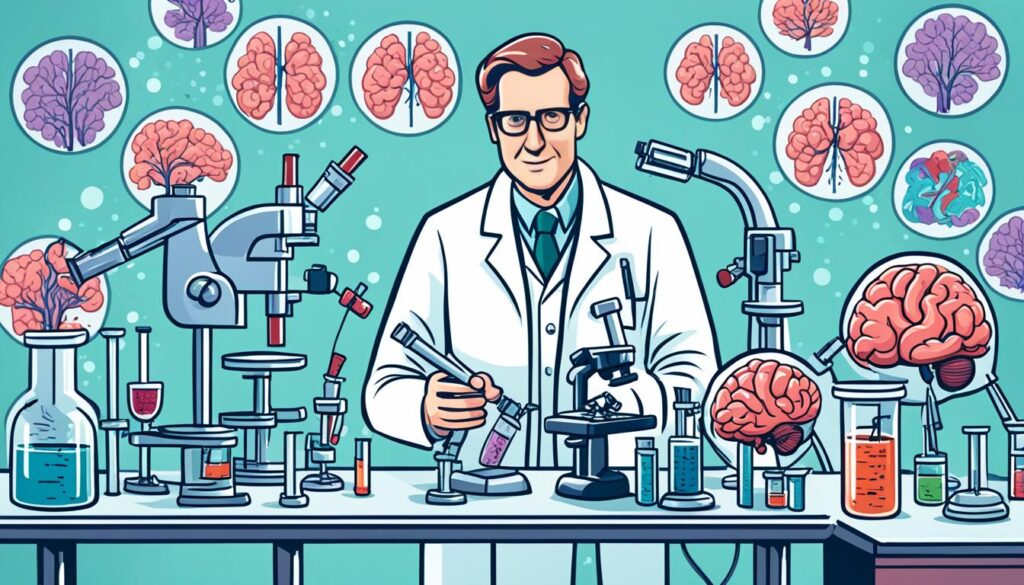Tardive dyskinesia (TD) is an involuntary movement disorder. It’s caused by taking specific drugs for a long time. These drugs help with certain psychiatric or stomach issues. But, over time, they can lead to strange and uncontrollable movements of the body. The jaw, lips, tongue, arms, and legs are commonly affected. TD is mainly linked to the use of antipsychotic drugs. Yet, some stomach medications, like metoclopramide, can also trigger it.
No one fully knows why TD affects some people but not others. Several elements can play a role. These include gender, age, how long you’ve been taking the drug, and race. Being aware of TD is crucial for those who take such medications. It helps them watch for early signs of this condition.
Table of Contents
ToggleWhat Is Tardive Dyskinesia?
Tardive dyskinesia (TD) is a disorder that causes uncontrollable movements. It’s linked to taking certain drugs for a long time. These drugs affect the brain’s dopamine system. The movements usually involve the face, lips, and tongue. But sometimes, the arms and legs are also affected.
Not everyone who takes these drugs will get TD. Yet, if you do get it, the problem can last forever. You might see stiff or jerky movements that you can’t stop. This can affect how your face and body move. For example, you might see people sticking their tongue out, blinking a lot, chewing, or smacking their lips.
The chance of getting TD goes up if you’ve been taking these drugs for a long time. Age, race (like being African American or Asian American), and certain times in women’s lives can also make TD more likely. Not all drugs are the same. The older ones are more often tied to TD than the newer ones. Some known drugs that could lead to Tardive dyskinesia are Haloperidol, Fluphenazine, Risperidone, and Olanzapine.
Anyone on these drugs should be checked for TD. Doctors use a scale to watch for its symptoms. Some stomach drugs, if used for over 3 months, can also cause TD. Diagnosing TD can be hard if the symptoms come after you stop the medication.
Symptoms of Tardive Dyskinesia
Tardive dyskinesia (TD) shows up as movements you can’t control in your face, lips, and tongue. It can cause things like grimacing, tongue movements, or mouth puckering. These actions happen on their own and affect your life a lot.
Orofacial Dyskinesia
The most seen TD form is orofacial dyskinesia, meaning your face, lips, and tongue move unexpectedly. You might see someone look like they’re frowning, keep their lips tight, or poke their tongue out. Such actions can make talking, eating, or just doing normal things tough.
Limb Dyskinesia
Sometimes, TD can affect your arms and legs, making them move without your say. This is limb dyskinesia. It can appear as sudden, twitchy moves (chorea) or slow, wavelike actions (athetosis) in the limbs. These moves make daily activities harder and lessen quality of life.

Causes of Tardive Dyskinesia
Tardive dyskinesia comes mainly from long-term use of certain drugs. These drugs include antipsychotics, used for mental illnesses. They work by blocking dopamine in the brain.
This can happen with other medicines, too. For example, metoclopramide treats stomach issues and prochlorperazine fights nausea. They also mess with dopamine, causing the jerky movements of tardive dyskinesia.
Antipsychotic Medications
Tardive dyskinesia is mostly from using antipsychotic medications for a long time. They treat illnesses like schizophrenia. By blocking dopamine, they cause body movements that you can’t control.
Metoclopramide and Other Gastrointestinal Medications
Some stomach medicines like metoclopramide can also bring on tardive dyskinesia. These drugs help with nausea and acid reflux problems. But they work against dopamine, which leads to the odd movements of tardive dyskinesia.
Risk Factors for Developing Tardive Dyskinesia
Several things can raise your chances of getting tardive dyskinesia. This is a condition where your body does sudden movements you can’t control. Knowing these risk factors is key for doctors and people using medications that might cause TD.
Gender and Age
Women, especially those past menopause, face a bigger risk of getting TD than men. Elderly patients are also more likely to get TD. This may be because our brains and bodies change as we age.
Duration of Medication Use
Taking drugs that block dopamine receptors for a long time ups your TD risk. This includes antipsychotics and certain meds for the stomach. Over time, using these drugs more can make TD more likely.
Ethnicity
Studies show people of African American or Asian heritage might have a higher TD risk if they use dopamine-blocking drugs for a long time. This is compared to Caucasians.

Pathophysiology of Tardive Dyskinesia
The exact cause of tardive dyskinesia (TD) is not fully known, but some ideas exist. One theory suggests that drugs blocking the brain’s dopamine D2 receptors could lead to more sensitive receptors. This can cause a stronger reaction to dopamine, leading to the uncontrollable movements seen in TD.
Dopamine Receptor Upregulation
Taking drugs that block dopamine receptors for a long time can make these receptors more sensitive in the brain. This stronger reaction to dopamine might play a big part in causing the involuntary movements of TD.
Oxidative Stress
Oxidative stress, which comes from dopamine being broken down, might also have a role. The direct toxic effects of antipsychotic drugs on brain cells can damage them. This damage can make the brain’s job harder, possibly making movement problems worse.
Withdrawal Dyskinesia
Stopping dopamine-blocking drugs can also cause a problem called withdrawal dyskinesia. This can make the brain even more sensitive to dopamine, making the movements in TD start or get worse.
These changes in the brain’s control of movement are thought to be the cause of the unique movements in TD. Knowing how these mechanisms work together is key to finding ways to prevent or treat this serious disorder.
Diagnosing Tardive Dyskinesia
Doctors diagnose tardive dyskinesia through a detailed process. They check the patient’s body movements closely. They also review the medicines the patient has taken. The Abnormal Involuntary Movement Scale (AIMS) helps doctors see how severe the symptoms are.
Physical Examination
During the checkup, doctors watch for certain involuntary movements. These movements can affect the face, lips, tongue, and more. They observe these movements to understand their frequency and how severe they are.
Abnormal Involuntary Movement Scale (AIMS)
AIMS is a tool that rates the level of tardive dyskinesia symptoms. It looks at body parts like the face, lips, and tongue. This tool helps determine the effects of these movements. It’s key for both diagnosis and tracking the condition over time.
Ruling Out Other Conditions
It’s important to check for other illnesses with similar symptoms. This includes diseases like Huntington’s and conditions such as cerebral palsy. Doctors may do brain tests to confirm tardive dyskinesia. A full check-up is critical to get the right diagnosis and treatment plan.

Treatment Options for Tardive Dyskinesia
If you’re dealing with tardive dyskinesia (TD), you have treatment choices. The main step is to check the medicines causing the twitching. Then, they might change those meds.
Medication Adjustments
Your doctor may stop the medicine that’s causing TD. Or, they could lower the dose. They might also suggest a new drug that’s less likely to make you twitch. Doing this can cut down on the TD effects. It could also stop it from getting worse.
FDA-Approved Medications
In 2017, the FDA gave the OK for two drugs to treat TD. These are valbenazine (Ingrezza) and deutetrabenazine (Austedo). They work by adjusting dopamine in the brain. This can lower the twitching from TD.
Natural Remedies
There’s little proof that natural options help with TD. Some studies looked at choline, vitamin E, and omega-3s. These might help as extra support. But, always talk to your doctor first. Natural remedies could affect your other medicines or cause problems.
Prevention Strategies for Tardive Dyskinesia
The best way to stop tardive dyskinesia is through watchful care. Doctors should keep a close eye on patients using certain medications. These include first-generation antipsychotics, which pose higher risks. Doctors should try to use second-generation antipsychotics as a safer option. This helps in handling the use of these medications better and lowering the risk of tardive dyskinesia.
It’s vital that patients are told about tardive dyskinesia. They should know how to spot any strange movements. They need to inform their healthcare team right away if they notice something odd. Using the Abnormal Involuntary Movement Scale (AIMS) for checks can help find tardive dyskinesia early. This early detection might stop it from getting worse and become a big problem.

Differential Diagnosis of Tardive Dyskinesia
When a patient shows signs of tardive dyskinesia (TD), doctors look at other conditions first. This is because many diseases have similar symptoms like uncontrollable movements. Conditions like Huntington’s disease, cerebral palsy, Tourette syndrome, and dystonia look similar but need different treatments.
Huntington’s Disease
Huntington’s disease causes jerky, twisting movements. It also affects thinking and can lead to mood changes. Although the movements can be alike in TD and Huntington’s, family history and other symptoms help doctors tell them apart.
Cerebral Palsy
Cerebral palsy is due to brain issues early in life. It makes people move slowly and have involuntary movements of the face and tongue. Doctors watch the pattern of symptoms to see if it’s cerebral palsy or TD.
Tourette Syndrome
Tourette syndrome makes people have sudden, uncontrollable sounds and movements. These can include making faces or sticking out the tongue. Looking at all the tics, not just the movements, helps in diagnosis.
Dystonia
Dystonia causes muscles to contract without control. This can lead to slow, twisting movements. By carefully checking the movements and health history, doctors can see if it’s TD or dystonia.
It’s crucial for doctors to rule out other conditions to treat TD right. They might use brain scans or genetic tests to be sure. This way, patients get the best care for their exact condition.
Epidemiology of Tardive Dyskinesia
Tardive dyskinesia is a common side effect of long-term antipsychotic use. It affects at least 20% of first-generation antipsychotic users. However, the rates can be as low as 1% with other drugs, such as some antidepressants.
Groups at high risk include women, the elderly, and those of African American or Asian descent. Middle-aged to older women show a higher TD risk than men. After menopause, this risk can jump to 30% after a year on these medications.
Older patients also face increased risk, likely due to age-related changes. African Americans have shown a higher TD risk after taking dopamine-blockers for a long time.
Though second-generation antipsychotic users have a lower TD risk, it’s not insignificant. The use of TD-causing drugs has also grown over the last 20 years, adding to the problem.
Those with ongoing mental health issues are more likely to develop TD. There are new treatments, like deutetrabenazine and valbenazine, that can help manage this condition now.
Impact on Quality of Life
Tardive dyskinesia can change your life in big ways. It causes body movements you can’t control. These movements can make it hard to eat, talk, or do tasks that need careful hand movements. You might start avoiding people or find it hard to keep up with friends. This can make you feel very bad about yourself. Even stopping the medicine that caused it doesn’t always make these effects go away. This can be very upsetting.
This issue doesn’t just affect how you move. It can also hurt how you see yourself and get along with others. Studies show people with tardive dyskinesia have a harder time with their health and social life. Those with severe TD had the worst health and life quality. If you have schizophrenia, TD can hit you even harder. But it’s also tough for people with bipolar disorder or major depression. In either case, life can feel a lot harder than for the average person.
Tardive dyskinesia reaches deep into your life. Many people say it makes other mental health problems worse. It can change how well your main mental health issue stays under control. And it can shake up how well you stick to your treatment plan. Doctors know how much TD affects you. They say it’s the main reason they start special treatments for TD.
This condition is no small thing. A good number of people who take certain medicines might get it. For many, it causes more than physical problems. It can lead to deep feelings of frustration, insecurity, and at its worst, thoughts of ending life. Dealing with TD may mean more trips to hospitals. It might also make finding or keeping a job harder, changing your work life a lot.
Dealing with the effects of tardive dyskinesia is really important. Knowing what you might face and finding help can make a huge difference. It’s crucial to focus on making your life better again. Remember, managing TD well is key for you and your care team.
Ongoing Research and Clinical Trials
Scientists are looking into new ways to treat and manage tardive dyskinesia research. Many clinical trials are testing the effectiveness of different medicines. These include newer antipsychotics and experimental drugs. The goal is to find better treatments to lessen involuntary movements and make life better for those with the condition.
A study from 2019 showed that people with bipolar disorder, major depressive disorder, and schizophrenia were affected. It changed their lives by causing involuntary movements. In 2017, it was found that the risk of these movements is lower with second-generation antipsychotics.
Along the way, a 2017 meta-analysis showed that tardive dyskinesia was less common with these second-generation antipsychotics. If you’re interested in joining a trial, you can find info on places like ClinicalTrials.gov. This website lists studies, including those funded by the government or private groups. Staying up-to-date can help you and your doctor find the best ways to tackle the symptoms and improve your life.

Awareness and Education Initiatives
It’s really important to make more people aware of tardive dyskinesia. Healthcare pros need to know how to spot the early signs and take preventive actions. This includes keeping a close eye on patients who are on certain meds.
Teaching patients is also key. They need to learn about the risks of tardive dyskinesia. And, they should know to report any strange body movements to their healthcare team. Knowing about treatment choices can be very helpful, too.
About 600,000 folks in the US have tardive dyskinesia. And almost 100 to 127 out of every 1,000 people taking certain meds may get it. Yet, many don’t know that lots of antipsychotic drugs can lead to this condition. It’s a big shortcoming in how we care for these individuals.
So, we need to fix this. Healthcare providers must learn to spot tardive dyskinesia early. They should watch patients closely if they’re on meds that might cause it. Teaching patients is equally vital. They need to understand the risks, know why they should point out any unusual movements, and be aware of how it can be treated.
By spreading more awareness and clear info on tardive dyskinesia, we can make a big difference. More people might get diagnosed sooner, paving the way for better care and outcomes. This could greatly improve the lives of those with tardive dyskinesia in many ways.
Conclusion
Tardive dyskinesia is a major health issue that affects your daily life. It causes involuntary movements in parts of your body. These movements might happen in your face, lips, tongue, or limbs. Long-term use of some drugs can lead to this condition.
It’s important to know the risk factors. Things like gender, age, and ethnicity play a part. Knowing about these can help in preventing and treating this condition. This is key knowledge for doctors and patients.
There is ongoing work to find new treatments for tardive dyskinesia. Education efforts are also working hard to help recognize and deal with it better. By working with your medical team, you can keep up with the latest info. This will help make good choices and lessen the disorder’s effects.
The number of people with tardive dyskinesia changes across groups. This shows why staying aware and doing regular checks is important. If you are taking certain medicines for a long time, be careful. Speaking up for your health and staying informed helps everyone battle this condition.
FAQ
What is tardive dyskinesia?
Tardive dyskinesia (TD) is a condition where people make movements they can’t control because of certain drugs. These drugs can include some psychiatric medicines and drugs used for stomach issues. The movements often happen in the face, lips, tongue, and sometimes in the arms and legs.
What are the primary symptoms of tardive dyskinesia?
One main sign of TD is when a person’s face or mouth moves strangely on its own. This is called orofacial dyskinesia. You might also see quick, sharp movements (chorea) or slow, twisting movements (athetosis) in their arms or legs. These are known as limb dyskinesia.
What causes tardive dyskinesia?
The main cause of TD is taking certain drugs for a long time. These drugs block dopamine receptors in the brain. Aside from psychiatric drugs, a stomach medicine called metoclopramide and an anti-nausea drug, prochlorperazine can also lead to TD.
What are the risk factors for developing tardive dyskinesia?
Many things can raise the chances of getting TD. This includes being a woman and getting older. The risk goes up the longer you use these drugs. Some races like African Americans and Asian Americans might also have a higher risk.
How is tardive dyskinesia diagnosed?
To diagnose TD, a doctor does a physical exam and checks your medicine history. They might use a test called the Abnormal Involuntary Movement Scale (AIMS). The doctor also checks to make sure it’s not something else causing the movements.
How is tardive dyskinesia treated?
The main way to treat TD is to stop or change the medications causing it. Sometimes, the doctor might switch you to a different drug. There are medicines like valbenazine that can help lessen the movements. Some natural remedies have been looked at but more research is needed on them.
How can tardive dyskinesia be prevented?
Doctors should watch over patients on these drugs closely. They should use newer medicines if possible to lower the TD risk. Patients should be told about TD and asked to report any strange movements. Regular screenings can find TD early.
How common is tardive dyskinesia?
At least 20% of people using first-generation antipsychotic drugs can get TD. The numbers are lower, between 1% to 10%, for other drugs that can cause TD.
How does tardive dyskinesia impact quality of life?
Having TD can make life harder. The movements can make daily life tough, leading to avoiding social situations or trouble in relationships. It can also make people feel embarrassed or self-conscious.
What is the current state of research and clinical trials for tardive dyskinesia?
Right now, scientists are working on new ways to treat and handle TD. We’re seeing new drug studies to see how well they work. These include both new and known drugs. The goal is to better understand and target what causes TD.
Source Links
- https://rarediseases.org/rare-diseases/tardive-dyskinesia/
- https://www.ncbi.nlm.nih.gov/books/NBK448207/
- https://www.webmd.com/mental-health/tardive-dyskinesia
- https://emedicine.medscape.com/article/1151826-overview
- https://medlineplus.gov/ency/article/000685.htm
- https://www.uptodate.com/contents/tardive-dyskinesia-etiology-risk-factors-clinical-features-and-diagnosis
- https://www.ncbi.nlm.nih.gov/pmc/articles/PMC7377543/
- https://www.healthline.com/health/treatment-options-tardive-dyskinesia
- https://www.ncbi.nlm.nih.gov/pmc/articles/PMC6591749/
- https://pubmed.ncbi.nlm.nih.gov/29022654/
- https://www.ccjm.org/page/mds-2023/td-quality-of-life
- https://www.ncbi.nlm.nih.gov/pmc/articles/PMC6863950/
- https://www.healthline.com/health/tardive-dyskinesia-quality-of-life
- https://www.ncbi.nlm.nih.gov/pmc/articles/PMC8412148/
- https://www.ncbi.nlm.nih.gov/pmc/articles/PMC8164384/
- https://www.psychiatrictimes.com/view/neurocrine-biosciences-announces-collaboration-with-participants-of-tardive-dyskinesia-awareness-week
- https://www.ncbi.nlm.nih.gov/pmc/articles/PMC5472076/

Best Neurologist Doctor In Patna: Dr Chandril Chugh Dedicated to Your Well-being
Dr.Chandril Chugh is a neurologist who trained and practiced in the USA for more than a decade. He is compassionate and caring and is most well known for being a patient listener and spending ample time with patients.
